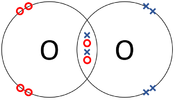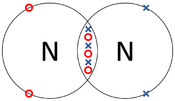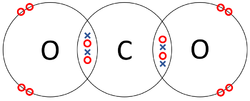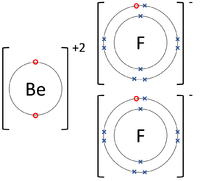Difference between revisions of "Dot and Cross Diagram"
(Created page with "==Key Stage 4== ===Meaning=== A '''dot and cross diagram''' is a diagram used to show how electrons from the outer shells of atoms are shared or tr...") |
|||
| (3 intermediate revisions by 2 users not shown) | |||
| Line 2: | Line 2: | ||
===Meaning=== | ===Meaning=== | ||
A '''dot and cross diagram''' is a [[diagram]] used to show how [[electron]]s from the [[Outer Shell|outer shells]] of [[atom]]s are shared or transferred in a [[Chemical Bond|chemical bond]]. | A '''dot and cross diagram''' is a [[diagram]] used to show how [[electron]]s from the [[Outer Shell|outer shells]] of [[atom]]s are shared or transferred in a [[Chemical Bond|chemical bond]]. | ||
| + | |||
| + | ===About Dot and Cross Diagrams=== | ||
| + | : '''Dot and cross diagrams''' can be used to represent [[Covalent Bond|covalent bonds]] and [[Ionic Bond|ionic bonds]]. | ||
| + | |||
| + | ===Examples=== | ||
| + | {| class="wikitable" | ||
| + | |+ Covalent Bonds | ||
| + | |- | ||
| + | |[[File:OxygenDotandCrossDiagram.png|center|175px]] | ||
| + | |[[File:NitrogenDotandCrossDiagram.png|center|175px]] | ||
| + | |[[File:CarbonDioxideDotandCrossDiagram.png|center|250px]] | ||
| + | |- | ||
| + | | style="height:20px; width:175px; text-align:center;" |The two [[Oxygen]] [[atom]]s each share two of their [[electron]]s with one another. | ||
| + | | style="height:20px; width:175px; text-align:center;" |The two [[Nitrogen]] [[atom]]s each share three of their [[electron]]s with one another. | ||
| + | | style="height:20px; width:250px; text-align:center;" |Each [[Oxygen]] shares two of its [[electron]]s with the [[Carbon]] [[atom]] while the [[Carbon]] [[atom]] shares two [[electron]]s with each [[Oxygen]] [[atom]]. | ||
| + | |} | ||
| + | |||
| + | {| class="wikitable" | ||
| + | |+ Ionic Bonds | ||
| + | |- | ||
| + | |[[File:LithiumFluorideDotandCrossDiagram.png|center|200px]] | ||
| + | |[[File:MagnesiumOxideDotandCrossDiagram.png|center|200px]] | ||
| + | |[[File:BerylliumFluorideDotandCrossDiagram.png|center|200px]] | ||
| + | |- | ||
| + | | style="height:20px; width:200px; text-align:center;" |The [[Lithium]] [[atom]] donates an [[electron]] from its [[Outer Shell|outer shell]] to the [[Outer Shell|outer shell]] of the [[Fluorine]] [[atom]]. | ||
| + | | style="height:20px; width:200px; text-align:center;" |The [[Magnesium]] [[atom]] donates two [[electron]]s from its [[Outer Shell|outer shell]] to the [[Outer Shell|outer shell]] of the [[Oxygen]] [[atom]]. | ||
| + | | style="height:20px; width:200px; text-align:center;" |The [[Beryllium]] [[atom]] donates two [[electron]]s from its [[Outer Shell|outer shell]] to the [[Outer Shell|outer shells]] of each [[Fluorine]] [[atom]]. | ||
| + | |} | ||
| + | |||
| + | |||
| + | ===References=== | ||
| + | ====AQA==== | ||
| + | |||
| + | :[https://www.amazon.co.uk/gp/product/0008158762/ref=as_li_tl?ie=UTF8&camp=1634&creative=6738&creativeASIN=0008158762&linkCode=as2&tag=nrjc-21&linkId=a0fffa35b3ea49a63404f6704e0df7cc ''Dot and cross diagram, pages 43, 60-1, 64-5, 133-5, GCSE Chemistry; Student Book, Collins, AQA ''] | ||
| + | :[https://www.amazon.co.uk/gp/product/1782945598/ref=as_li_tl?ie=UTF8&camp=1634&creative=6738&creativeASIN=1782945598&linkCode=as2&tag=nrjc-21&linkId=ad276ad49df77ab4b40ab4fd0fe09861 ''Dot and cross diagrams, pages 114, 116, 117, GCSE Combined Science; The Revision Guide, CGP, AQA ''] | ||
| + | :[https://www.amazon.co.uk/gp/product/1782945571/ref=as_li_tl?ie=UTF8&camp=1634&creative=6738&creativeASIN=1782945571&linkCode=as2&tag=nrjc-21&linkId=9e29fad914244909903e5e93f8a01d106 ''Dot and cross diagrams, pages 29, 31, 32, GCSE Chemistry; The Revision Guide, CGP, AQA ''] | ||
| + | :[https://www.amazon.co.uk/gp/product/0198359381/ref=as_li_tl?ie=UTF8&camp=1634&creative=6738&creativeASIN=0198359381&linkCode=as2&tag=nrjc-21&linkId=47c8d1ae58d8b3a5e2094cd447154558 ''Dot and cross diagrams, pages 39, 44-45, GCSE Chemistry; Third Edition, Oxford University Press, AQA ''] | ||
| + | :[https://www.amazon.co.uk/gp/product/178294639X/ref=as_li_tl?ie=UTF8&camp=1634&creative=6738&creativeASIN=178294639X&linkCode=as2&tag=nrjc-21&linkId=51599bb45a2bfaf7c1b6a978b2ca2616 ''Dot and cross diagrams, pages 72-76, 78, 79, 81-83, GCSE Combined Science Trilogy; Chemistry, CGP, AQA ''] | ||
| + | :[https://www.amazon.co.uk/gp/product/1782945962/ref=as_li_tl?ie=UTF8&camp=1634&creative=6738&creativeASIN=1782945962&linkCode=as2&tag=nrjc-21&linkId=476bb5c8d1dfb5c08ac81b6d4d1c98d8 ''Dot and cross diagrams, pages 74-78, 80, 81, 83-85, GCSE Chemistry, CGP, AQA ''] | ||
| + | |||
| + | ====Edexcel==== | ||
| + | |||
| + | :[https://www.amazon.co.uk/gp/product/1292120193/ref=as_li_tl?ie=UTF8&camp=1634&creative=6738&creativeASIN=1292120193&linkCode=as2&tag=nrjc-21&linkId=572df39392fb4200db8391d98ae6314e ''Dot and cross diagrams, page 184, GCSE Combined Science, Pearson Edexcel ''] | ||
| + | :[https://www.amazon.co.uk/gp/product/1292120215/ref=as_li_tl?ie=UTF8&camp=1634&creative=6738&creativeASIN=1292120215&linkCode=as2&tag=nrjc-21&linkId=8f96ddb76196848bafdb124354e4cf77 ''Dot and cross diagrams, page 40, GCSE Chemistry, Pearson, Edexcel ''] | ||
| + | :[https://www.amazon.co.uk/gp/product/1782945725/ref=as_li_tl?ie=UTF8&camp=1634&creative=6738&creativeASIN=1782945725&linkCode=as2&tag=nrjc-21&linkId=694be7494de75af3349537d34e13f7f0 ''Dot and cross diagrams, pages 21, 23, GCSE Chemistry; The Revision Guide, CGP, Edexcel ''] | ||
| + | :[https://www.amazon.co.uk/gp/product/1782948147/ref=as_li_tl?ie=UTF8&camp=1634&creative=6738&creativeASIN=1782948147&linkCode=as2&tag=nrjc-21&linkId=f63dcd8345f4e49c717b39a228a36c7c ''Dot and cross diagrams, pages 51-53, 56, 58-60, GCSE Chemistry, CGP, Edexcel ''] | ||
| + | :[https://www.amazon.co.uk/gp/product/1782945741/ref=as_li_tl?ie=UTF8&camp=1634&creative=6738&creativeASIN=1782945741&linkCode=as2&tag=nrjc-21&linkId=30da4f2178da182547b62a7329d13b57 ''Dot and cross diagrams, pages 84, 86, GCSE Combined Science; The Revision Guide, CGP, Edexcel ''] | ||
| + | |||
| + | ====OCR==== | ||
| + | :[https://www.amazon.co.uk/gp/product/1782945679/ref=as_li_tl?ie=UTF8&camp=1634&creative=6738&creativeASIN=1782945679&linkCode=as2&tag=nrjc-21&linkId=a2db42f7b4bdf10cafaafa3bb9120940 ''Dot and cross diagrams, pages 19, 20, Gateway GCSE Chemistry; The Revision Guide, CGP, OCR ''] | ||
| + | :[https://www.amazon.co.uk/gp/product/1782945695/ref=as_li_tl?ie=UTF8&camp=1634&creative=6738&creativeASIN=1782945695&linkCode=as2&tag=nrjc-21&linkId=ceafcc80bcad6b6754ee97a0c7ceea53 ''Dot and cross diagrams, pages 90, 92, Gateway GCSE Combined Science; The Revision Guide, CGP, OCR ''] | ||
| + | :[https://www.amazon.co.uk/gp/product/0198359829/ref=as_li_tl?ie=UTF8&camp=1634&creative=6738&creativeASIN=0198359829&linkCode=as2&tag=nrjc-21&linkId=90e8d7b4f039d53035238fa0320fe00b ''Dot-and-cross diagrams, pages 57, 58, 60, Gateway GCSE Chemistry, Oxford, OCR ''] | ||
Latest revision as of 00:57, 5 December 2019
Contents
Key Stage 4
Meaning
A dot and cross diagram is a diagram used to show how electrons from the outer shells of atoms are shared or transferred in a chemical bond.
About Dot and Cross Diagrams
- Dot and cross diagrams can be used to represent covalent bonds and ionic bonds.
Examples
| The two Oxygen atoms each share two of their electrons with one another. | The two Nitrogen atoms each share three of their electrons with one another. | Each Oxygen shares two of its electrons with the Carbon atom while the Carbon atom shares two electrons with each Oxygen atom. |
| The Lithium atom donates an electron from its outer shell to the outer shell of the Fluorine atom. | The Magnesium atom donates two electrons from its outer shell to the outer shell of the Oxygen atom. | The Beryllium atom donates two electrons from its outer shell to the outer shells of each Fluorine atom. |
References
AQA
- Dot and cross diagram, pages 43, 60-1, 64-5, 133-5, GCSE Chemistry; Student Book, Collins, AQA
- Dot and cross diagrams, pages 114, 116, 117, GCSE Combined Science; The Revision Guide, CGP, AQA
- Dot and cross diagrams, pages 29, 31, 32, GCSE Chemistry; The Revision Guide, CGP, AQA
- Dot and cross diagrams, pages 39, 44-45, GCSE Chemistry; Third Edition, Oxford University Press, AQA
- Dot and cross diagrams, pages 72-76, 78, 79, 81-83, GCSE Combined Science Trilogy; Chemistry, CGP, AQA
- Dot and cross diagrams, pages 74-78, 80, 81, 83-85, GCSE Chemistry, CGP, AQA
Edexcel
- Dot and cross diagrams, page 184, GCSE Combined Science, Pearson Edexcel
- Dot and cross diagrams, page 40, GCSE Chemistry, Pearson, Edexcel
- Dot and cross diagrams, pages 21, 23, GCSE Chemistry; The Revision Guide, CGP, Edexcel
- Dot and cross diagrams, pages 51-53, 56, 58-60, GCSE Chemistry, CGP, Edexcel
- Dot and cross diagrams, pages 84, 86, GCSE Combined Science; The Revision Guide, CGP, Edexcel





